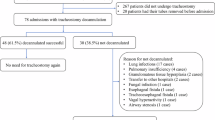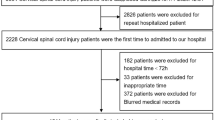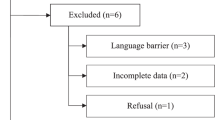Abstract
Study design
Retrospective study.
Objectives
To investigate the risk factors associated with tracheostomy after traumatic cervical spinal cord injury (CSCI) and to identify factors associated with decannulation in an aging population.
Setting
Advanced critical care and emergency center in Yokohama, Japan.
Methods
Sixty-five patients over 60 years with traumatic CSCI treated between January 2010 and June 2017 were enrolled. The parameters analyzed were age, sex, American Spinal Injury Association impairment scale score (AIS) at admission and one year after injury, neurological level of injury (NLI), injury mechanism, Charlson’s comorbidity index (CCI), smoking history, radiological findings, intubation at arrival, treatment choice, length of intensive care unit (ICU) stay, tracheostomy rate, improvement of AIS, decannulation rate, and mortality after one year.
Results
The study included 48 men (74%; mean age 72.8 ± 8.3 years). Twenty-two (34%), 10 (15%), 24 (37%), and 9 (14%) patients were classified as AIS A, B, C, and D, respectively. The tracheostomy group showed significantly more severe degree of paralysis, more patients with major fractures or dislocations, more operative treatment, longer ICU stay, poorer improvement in AIS score after one year and higher rate of intubation at arrival. AIS A at injury was the most significant risk factor for tracheostomy. The non-decannulation group had a significantly higher mortality. The risk factor for failure of decannulation was CCI.
Conclusions
Risk factors for tracheostomy after traumatic CSCI were AIS A, operative treatment, major fracture/dislocation, and intubation at arrival. The only factor for failure of decannulation was CCI.
Similar content being viewed by others
Login or create a free account to read this content
Gain free access to this article, as well as selected content from this journal and more on nature.com
or
Data archiving
All data generated or analyzed during this study are included in this published article and a supplementary file.
References
Brown R, DiMarco AF, Hoit JD, Garshick E. Respiratory dysfunction and management in spinal cord injury. Respir Care. 2006;51:853–70.
Flanagan CD, Childs BR, Moore TA, Vallier HA. Early tracheostomy in patients with traumatic cervical spinal cord injury appears safe and may improve outcomes. Spine. 2018;43:1110–6.
Ganuza JR, Forcada AG, Gambarrutta C, Buigues ED, Gonzalez VE, Fuentes FP, et al. Effect of technique and timing of tracheostomy in patients with acute traumatic spinal cord injury undergoing mechanical ventilation. J Spin Cord Med. 2011;34:76–80.
Beom JY, Seo HY. The need for early tracheostomy in patients with traumatic cervical cord injury. Clin Orthop Surg. 2018;10:191–6.
Harrop JS, Sharan AD, Scheid JrEH, Vaccaro AR, Przybylski GJ. Tracheostomy placement in patients with complete cervical spinal cord injuries: American Spinal Injury Association grade A. J Neurosurg Spine. 2004;100:20–23.
Yugue I, Okada S, Ueda T, Maeda T, Mori E, Kawano O. Analysis of the risk factors for tracheostomy in traumatic cervical spinal cord injury. Spine. 2012;37:E1633–8.
Kim DH, Kang SW, Choi WA, Oh HJ. Successful tracheostomy decannulation after complete or sensory incomplete cervical spina cord injury. Spinal Cord. 2017;55:601–5.
Gilony D, Gilboa D, Blumstein T, Murad H, Talmi YP, Kronenberg J, et al. Effects of tracheostomy on well-being and body-image perceptions. Otolaryngol Head Neck Surg. 2005;133:366–71.
Nakashima H, Yukawa Y, Imagama S, Ito K, Hida T, Machino M, et al. Characterizing the need for tracheostomy placement and decannulation after cervical spinal cord injury. Eur Spine J. 2013;22:1526–32.
Fasset DR, Harrop JS, Maltenfort M, Jeyamohan SB, Ratliff JD, Anderson DG, et al. Mortality rates in geriatric patients with spinal cord injuries. J Neurosurg Spine. 2007;7:277–81.
Hagen EM, Aarli JA, Gronning M. The clinical significance of spinal cord injuries in patients older than 60 years of age. Acta Neurol Scand. 2005;112:42–47.
Pickett GE, Campos-Benitez M, Keller JL, Duggal N. Epidemiology of traumatic spinal cord injury in Canada. Spine. 2006;31:799–805.
Sakai H, Ueda T, Shiba K. Current situation of medical care for spinal cord injury in Japan. J Spine Res. 2010;1:41–51.
Lidal IB, Snekkevik H, Aamodt G, Hjeltnes N, Stanghelle JK, Biering-Sørensen F. Mortality after spinal cord injury in Norway. J Rehabil Med. 2007;39:145–51.
Maynard FM Jr, Bracken MB, Creasey GJ, Ditunno JF, Donovan WH, et al. International standards for neurological and functional classification of spinal cord injury. Spinal Cord. 1997;35:266–74.
Charlson ME, Pompei P, Ales KL, MacKenzie CR. A new method of classifying prognostic comorbidity in longitudinal studies: development and validation. J Chron Dis. 1987;40:373–83.
Reins DH, Harris RC. Pulmonary complications of acute spinal cord injuries. Neurosurgery. 1987;21:193–6.
Childs BR, Moore TA, Como JJ, Vallier HA. American spinal injury association impairment scale predicts the need for tracheostomy after cervical spinal cord injury. Spine. 2015;40:1407–13.
Romero J, Vari A, Ganbarrutta C, Oliviero A. Tracheostomy timing in traumatic spinal cord injury. Eur Spine J. 2009;18:1452–7.
Shao J, Zhu W, Chen X, Jia L, Song D, Zhou X, et al. Factors associated with early mortality after cervical spinal cord injury. J Spinal Cord Med. 2011;34:555–62.
Tanaka J, Yugue I, Shiba K, Maeyama A, Naito M. A study of risk factors for tracheostomy in patients with a cervical spinal cord injury. Spine. 2016;41:764–71.
Wang Y, Guo Z, Fan D, Lu H, Xie D, Zhang D, et al. A meta-analysis of the influencing factors for tracheostomy after cervical spinal cord injury. Biomed Res Int. 2018; [Epub ahead of print] https://doi.org/10.1155/2018/5895830.
DeVivo MJ, Kartus PL, Rutt RD, Stover SL, Fine PR. The influence of age at time of spinal cord injury on rehabilitation outcome. Arch Neurol. 1990;47:687–91.
Engoren MC, Arslanian-Engoren CM. Outcome after tracheostomy for respiratory failure in the elderly. J Intensive Care Med. 2005;20:104–10.
Como JJ, Sutton ER, McCunn M, Dutton RP, Johnson SB, Aarabi B, et al. Characterizing the need for mechanical ventilation following cervical spinal cord injury with neurologic deficit. J Trauma. 2005;59:912–6.
Takao T, Okada S, Morishita Y, Maeda T, Kubota K, Ideta R, et al. Clinical influence of cervical spinal canal stenosis on neurological outcome after traumatic cervical spinal cord injury without major fracture or dislocation. Asian Spine J. 2016;10:536–42.
Hayashi T, Fujiwara Y, Sakai H, Maeda T, Ueta T, Shiba K. Risk factors for severe dysphagia in acute cervical spinal cord injury. Spinal Cord. 2017;55:940–3.
Xing D, Wang J, Song D, Xu W, Chen Y, Yang Y, et al. Predictors for mortality in elderly patients with cervical spine injury: a systematic methodological review. Spine. 2013;38:770–7.
Alsaleh K, Bednar D, Farrokhyar F. Acute traumatic quadriplegia in adults: predictors of acute in-hospital mortality. Turk Neurosurg. 2017;27:942–5.
Harris MB, Reichmann WM, Bono CM, Bouchard K, Corbett KL, Warholic N, et al. Mortality in elderly patients after cervical spine fractures. J Bone Jt Surg Am. 2010;92:567–74.
Acknowledgements
We are grateful to Editage for the English language review.
Author information
Authors and Affiliations
Contributions
TH, HE, YW, and MS were responsible for study conception and design, acquisition of data, statistics, analysis and interpretation of data, and drafting of manuscript. TS and YI were involved in analysis and interpretation of data, and drafting of manuscript.
Corresponding author
Ethics declarations
Ethical approval
This study was approved by the ethics research board of the Yokohama City University School of Medicine. The reference number is B17080001. We certify that all applicable institutional and governmental regulations concerning the ethical use of human volunteers were followed during the course of this research.
Conflict of interest
The authors declare that they have no conflict of interest.
Additional information
Publisher’s note: Springer Nature remains neutral with regard to jurisdictional claims in published maps and institutional affiliations.
Supplementary information
Rights and permissions
About this article
Cite this article
Higashi, T., Eguchi, H., Wakayama, Y. et al. Analysis of the risk factors for tracheostomy and decannulation after traumatic cervical spinal cord injury in an aging population. Spinal Cord 57, 843–849 (2019). https://doi.org/10.1038/s41393-019-0289-x
Received:
Revised:
Accepted:
Published:
Issue Date:
DOI: https://doi.org/10.1038/s41393-019-0289-x
This article is cited by
-
The influencing factors for tracheostomy decannulation after traumatic cervical spinal cord injury: a retrospective study
Spinal Cord (2025)
-
Long-term trends and risk factors of tracheostomy and decannulation in patients with cervical spinal cord Injury
Spinal Cord (2024)
-
Predicting extubation in patients with traumatic cervical spinal cord injury using the diaphragm electrical activity during a single maximal maneuver
Annals of Intensive Care (2023)
-
The shoulder abductor strength is a novel predictor of tracheostomy in patients with traumatic cervical spinal cord injury
BMC Musculoskeletal Disorders (2022)
-
Classification and regression tree (CART) model to assist clinical prediction for tracheostomy in patients with traumatic cervical spinal cord injury: a 7-year study of 340 patients
European Spine Journal (2022)



